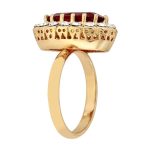The history of African jewelry and art is a rich tapestry that dates back thousands of years, reflecting the diverse cultures and traditions of the continent. From intricate beadwork to intricate metalwork, African jewelry and art have played a significant role in the expression of individual and communal identity, as well as serving practical and symbolic purposes.
This article will delve into the origins, cultural significance, evolution, techniques and materials used, symbolism and meanings, as well as the influence of African jewelry and art on global fashion and trends. We will also explore famous pieces and artists, as well as efforts to preserve and revive traditional African jewelry and art.
African jewelry and art have deep roots in ancient traditions that continue to thrive in contemporary society. These adornments are not just decorative but hold cultural significance representing religion, spirituality, social status, wealth or allegiance. The styles vary greatly between regions due to Africa’s diversity of ethnic groups each with their own unique customs that are reflected in their craftmanship.
As we journey through this exploration of African jewelry and art, we will gain insight into the enduring legacy of these timeless creations. Get ready to embark on a fascinating discovery that spans centuries and continents showcasing the ingenuity, creativity, craftsmanship, symbolism and cultural importance embedded within each unique piece of African jewelry and art.
Origins and Cultural Significance of African Jewelry and Art
The origins of African jewelry and art can be traced back thousands of years, with evidence of intricate beadwork and metalwork dating back to ancient civilizations such as the Nubians, Egyptians, and Carthaginians. These early forms of adornment were not only decorative but also held cultural and spiritual significance for the wearer.
Jewelry was often used as a status symbol, signifying wealth, power, and social standing within the community. In addition, many pieces of African jewelry held religious or ceremonial significance, with certain materials and symbols being associated with specific deities or rituals.
Cultural diversity across the African continent has resulted in a wide array of styles and techniques in jewelry-making and artistic expression. From the vibrant colors and elaborate beadwork of the Maasai people to the intricate gold filigree work of the Akan of Ghana, each region has developed its own distinct aesthetic and craftsmanship. This diversity reflects the rich tapestry of traditions, beliefs, and customs that have shaped African societies for centuries.
African jewelry and art are deeply intertwined with storytelling and oral tradition, serving as a means of passing down history, myths, and proverbs from one generation to the next. Symbols such as animals, plants, and geometric patterns are often incorporated into jewelry designs to convey specific meanings or convey moral lessons.
For example, the Adinkra symbols of the Akan people carry messages related to wisdom, bravery, unity, or humility. The use of these symbols in jewelry not only adds visual appeal but also serves as a form of communication within the community.
- The use of beads in African jewelry
- Metalworking techniques in different African cultures
- Religious and ceremonial significance of African jewelry
- Influence of oral tradition on visual storytelling in African art
Evolution of African Jewelry and Art Through the Ages
The evolution of African jewelry and art through the ages is a testament to the rich and diverse cultural heritage of the continent. From ancient times to the present day, African jewelry and art have been an essential part of daily life, ceremonies, and rituals. The history of African jewelry and art dates back thousands of years, with each region showcasing its unique techniques, materials, and designs.
In ancient Africa, jewelry and art were not only decorative but also held significant cultural and spiritual meanings. For example, in many African societies, certain jewelry pieces were worn as symbols of social status, marital status, or even protection against evil spirits. Art forms such as masks, sculptures, and textiles also played a crucial role in religious ceremonies, storytelling, and communicating with ancestors.
As time passed and trade routes expanded, African jewelry and art began to incorporate influences from other cultures. This was especially evident during the colonial era when European explorers introduced new materials such as glass beads and metals. Despite these external influences, traditional techniques such as beadwork, metal casting, carving, weaving, and embroidery remained integral to the production of African jewelry and art.
Throughout history, African jewelry and art have continued to evolve alongside societal changes and technological advancements. Today, contemporary African artists are blending traditional craftsmanship with modern aesthetics to create innovative pieces that resonate with global audiences. This continuum of creativity reflects the enduring legacy of African jewelry and art in shaping artistic expressions worldwide.
| Evolution of African Jewelry | Art Through the Ages |
|---|---|
| Ancient times to present day | African societies’ unique techniques, |
| cultural significance, | materials used in production. |
| Incorporation of external | societal changes |
| influences like glass beads & |
Techniques and Materials Used in African Jewelry and Art
African jewelry and art have a rich history dating back centuries, with techniques and materials playing a crucial role in the creation of these stunning pieces. The craftsmanship and attention to detail in African jewelry and art have made them highly sought after and revered around the world.
Techniques Used in African Jewelry and Art:
– Beadwork: Beads have been a central feature of African jewelry for centuries, with intricate patterns and vibrant colors being used to create stunning necklaces, bracelets, and other adornments. The beadwork is often done by hand, with each piece reflecting the unique cultural traditions of the region it comes from.
– Metalwork: African artisans are known for their exceptional metalworking skills, using techniques such as casting, forging, and filigree to create elaborate jewelry pieces. Gold, silver, copper, and brass are commonly used metals in African jewelry, often symbolizing wealth and status within the community.
– Textile work: Fabric plays an important role in African art as well. From beautifully embroidered garments to intricately woven textiles used in traditional headpieces or ceremonial attire, textiles are an integral part of African cultural heritage that are often incorporated into jewelry design.
Materials Used in African Jewelry and Art:
1. Gold: Considered a symbol of wealth and prosperity across many African cultures, gold has been used for millennia to create exquisite jewelry pieces.
2. Cowrie shells: These small shells have been used as currency across various regions of Africa for centuries. Today, they continue to be used in traditional jewelry making for their symbolic significance.
3. Ivory: Historically valued for its rarity and beauty but now largely replaced by sustainable alternatives due to concerns over wildlife conservation.
4. Gemstones: Precious stones such as turquoise, lapis lazuli, carnelian, and amber are often incorporated into African jewelry designs for their vibrant colors and spiritual significance within different communities.
The use of these techniques and materials reflects the diverse cultural traditions found across the continent of Africa. They play a vital role in not only creating beautiful works of art but also preserving the rich history of African jewelry-making practices.
Overall, understanding the intricate techniques employed in crafting African jewelry provides insight into the cultural significance behind each piece. Similarly, recognizing the variety of materials utilized sheds light on how symbolic elements are interwoven into artistic creations which endure generations after generations as heirlooms carrying deep connections to culture at large.
Symbolism and Meanings Behind African Jewelry and Art
The symbolism and meanings behind African jewelry and art are deeply rooted in the spirituality, traditions, and cultural beliefs of various African communities. Each piece of jewelry or art conveys a specific message or represents a significant aspect of the wearer’s identity, social status, or heritage. From ancient times to the present day, African jewelry and art have served as powerful symbols of cultural pride, spiritual protection, and communal belonging.
In many African cultures, jewelry is not just decorative; it also carries great symbolic importance. For example, certain beads or amulets may be worn to offer protection from harm or ward off evil spirits. Additionally, specific materials such as gold, copper, or cowrie shells often symbolize wealth, power, or fertility within different African societies. These symbols and meanings are passed down through generations, preserving the rich cultural heritage and traditions associated with African jewelry and art.
Furthermore, African jewelry and art often serve as visual representations of historical events, social structures, or religious beliefs within diverse African communities. For instance, intricate patterns and motifs found in traditional African beadwork may convey narratives of triumph over adversity or depict ancestral stories that hold deep spiritual significance for the wearers. By understanding the symbolism and meanings behind these pieces, one gains insight into the complex history and traditions embodied in African jewelry and art.
Ultimately, the symbolic nature of African jewelry and art reflects the interconnectedness between individuals within their communities and their spiritual worldview. The enduring legacy of these symbols continues to inspire contemporary artists and designers who seek to preserve and celebrate the profound cultural significance embedded in every piece of African jewelry and artwork.
Influence of African Jewelry and Art on Global Fashion and Trends
The history of African jewelry and art is rich, diverse, and deeply rooted in the continent’s culture and traditions. Throughout the ages, African jewelry and art have had a significant influence on global fashion and trends, inspiring designers, artists, and fashion enthusiasts all over the world.
One of the most prominent ways in which African jewelry and art have influenced global fashion is through the use of traditional African motifs, patterns, and techniques in contemporary design. From bold geometric shapes to intricate beadwork, these elements have made their way into the collections of top fashion houses and are often seen on runways during international fashion weeks.
The use of vibrant colors and innovative textures in African jewelry and art has also been embraced by designers looking to infuse their creations with a sense of cultural richness and diversity.
Another aspect of African jewelry and art that has had a lasting impact on global fashion is the emphasis on craftsmanship and artisanal techniques. The tradition of handcrafting unique pieces using age-old methods has inspired a return to artisanal practices in modern fashion. Many designers are now collaborating with African artisans to create one-of-a-kind jewelry pieces that celebrate the heritage and skill behind traditional African craftsmanship.
Furthermore, African jewelry and art have also influenced global fashion by challenging conventional beauty standards. The celebration of natural materials such as wood, bone, shells, and brass in African jewelry has encouraged a shift towards sustainable and ethically sourced materials in the fashion industry.
| Aspect | Impact |
|---|---|
| Traditional motifs, patterns, techniques | Inspired designs of top fashion houses |
| Craftsmanship & artisanal techniques | Promoted return to artisanal practices in modern fashion |
| Challenging beauty standards | Encouraged shift towards sustainable & ethically sourced materials |
Famous African Jewelry and Art Pieces and Artists
The Gold of Mapungubwe
One of the most famous African jewelry pieces is “The Gold of Mapungubwe”, discovered in South Africa in the 1930s. This collection of gold artifacts, including a golden rhinoceros, is believed to date back to the 13th century and showcases the advanced metallurgical skills and sophisticated artistic techniques of the people of Mapungubwe. The discovery also underscores the rich history and intricate craftsmanship of African jewelry.
Benin Bronzes
The Benin Bronzes are a collection of brass plaques and sculptures created by the Edo people of Benin City, Nigeria. These iconic artworks date back to the 13th century and were created using the lost-wax casting technique. Although they are not strictly jewelry, these pieces hold significant cultural and artistic value. They depict scenes from royal ceremonies, daily life, and mythology, reflecting the historical richness and artistic prowess of African civilization.
Gerard Sekoto
Gerard Sekoto was a South African artist known for his paintings as well as his contributions to the world of African jewelry. His metalwork pieces often incorporated traditional motifs and symbols, reflecting a blend of modernity with cultural heritage. His work has been instrumental in showcasing the beauty and significance of African art on an international platform.
Mary Sibande
Mary Sibande is a contemporary South African artist renowned for her thought-provoking sculptures that often incorporate elements of jewelry and fashion. Through her work, Sibande challenges societal norms and addresses issues such as gender inequality, identity, and representation. Her innovative approach to incorporating jewelry into her art has garnered widespread acclaim and has helped put a spotlight on the intersection between contemporary art, fashion, and traditional adornment in Africa.
Preservation and Revival of Traditional African Jewelry and Art
African jewelry and art have a rich and diverse history that dates back centuries. The preservation and revival of traditional African jewelry and art are crucial in ensuring that these cultural treasures continue to be appreciated and celebrated for generations to come. Through various efforts, the traditions and techniques of creating African jewelry and art have been preserved, while also being adapted to modern times.
Efforts in Preservation
In recent years, there has been a growing awareness of the importance of preserving traditional African jewelry and art. Organizations, museums, and educational institutions have taken on the task of documenting, archiving, and showcasing these pieces. This not only helps to educate people about the significance of these artworks but also ensures that they are not lost to history.
Revival of Traditional Techniques
Many artisans and craftspeople are dedicated to reviving traditional techniques in creating African jewelry and art. By using ancient methods such as beadwork, casting, weaving, and carving, they are able to create contemporary pieces that still bear the hallmarks of their cultural heritage. This revival not only keeps these traditions alive but also provides a source of income for communities that rely on these skills for their livelihoods.
Collaborations With Contemporary Designers
Another important aspect of preserving traditional African jewelry and art is through collaborations with contemporary designers. By infusing modern aesthetics with traditional craftsmanship, new interpretations of African jewelry and art are being created. This not only introduces these forms of expression to a wider audience but also gives them relevance in today’s global fashion landscape. Through these collaborative efforts, the legacy of African jewelry and art continues to thrive in the 21st century.
Conclusion
In conclusion, the history of African jewelry and art is a rich tapestry woven with cultural significance, evolving techniques, and enduring symbolism. From its origins in ancient civilizations to its influence on global fashion and trends today, African jewelry and art have left an indelible mark on the world.
The use of materials such as gold, copper, beads, and natural elements like shells and ivory have been central to the creation of these pieces, showcasing the resourcefulness and creativity of African artisans throughout history.
The symbolism behind African jewelry and art reflects the values, beliefs, and traditions of diverse communities across the continent. Each piece tells a story, whether it’s through intricate carvings, elaborate beadwork, or symbolic motifs. These narratives have captivated people around the world and continue to inspire artists and designers in contemporary times.
As we look to the future, it is essential to preserve and revitalize traditional African jewelry and art forms. By doing so, we honor the legacy of past generations while also providing opportunities for current artisans to contribute to the ongoing narrative of this rich cultural heritage. The enduring legacy of African jewelry and art serves as a testament to the creativity, ingenuity, and resilience of African peoples throughout history.
Frequently Asked Questions
What Is the History of the African Jewelry?
The history of African jewelry dates back thousands of years and varies greatly across the continent, with each region having its unique style and significance. Jewelry was often used to symbolize status, wealth, and cultural heritage. Some of the earliest forms of African jewelry were made from materials like shells, beads, metals, and ivory.
What Does African Jewelry Symbolize?
African jewelry symbolizes various aspects of life such as social status, religious beliefs, spiritual protection, and cultural identity. For example, certain pieces may represent a person’s tribal affiliation or marital status. Additionally, jewelry is often adorned with symbols that hold deep meanings within African cultures, such as fertility, wisdom, or protection from evil spirits.
Why Do Africans Wear So Much Jewelry?
Africans wear a lot of jewelry for a multitude of reasons. One reason is to display their social or economic status within their community. Additionally, wearing jewelry can be a way to honor one’s ancestors and preserve cultural traditions.
Jewelry is also worn for spiritual reasons; certain pieces are believed to offer protection or ward off negative energy in different aspects of life. Overall, the wearing of jewelry in African culture holds deep significance and meaning beyond just adornment.

Welcome to my jewelry blog! My name is Sarah and I am the owner of this blog.
I love making jewelry and sharing my creations with others.
So whether you’re someone who loves wearing jewelry yourself or simply enjoys learning about it, be sure to check out my blog for insightful posts on everything related to this exciting topic!





